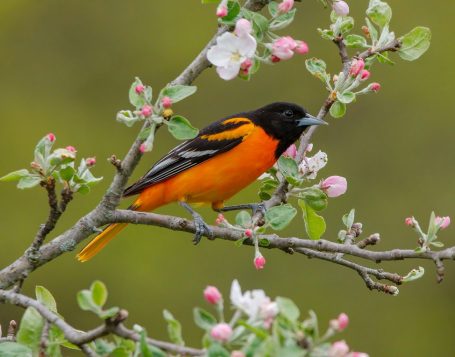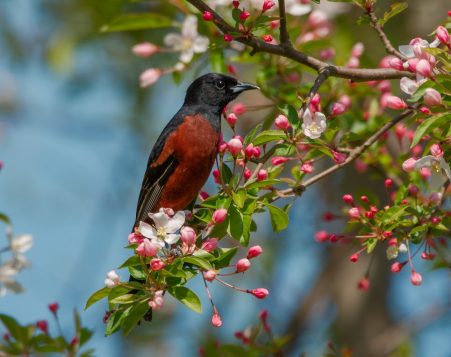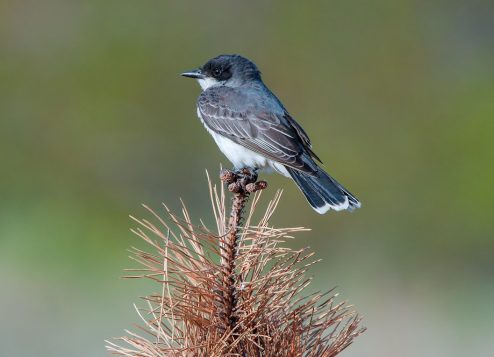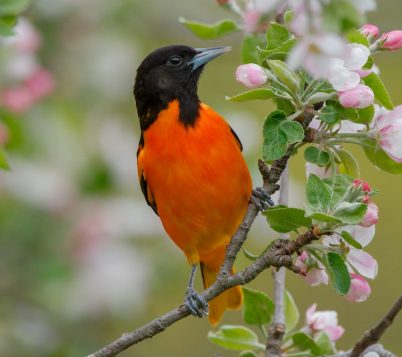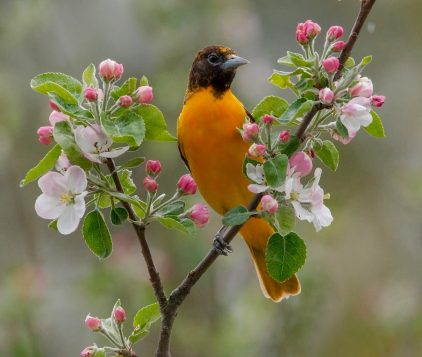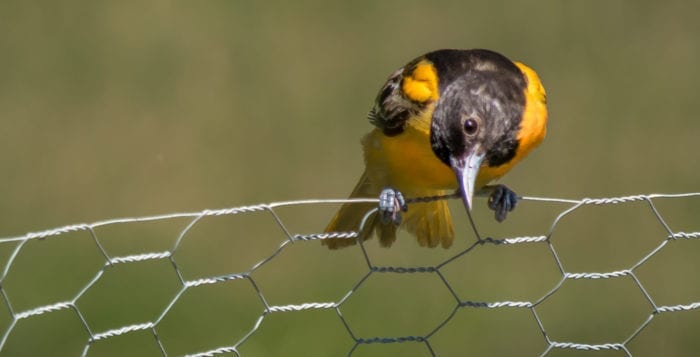By John L. Turner
For me, it is the most anticipated song of spring and until I hear it, typically the first day or two in May, the season is incomplete. The song is enthusiastic and energetic, sweet, and forceful — and unmistakable. The song belongs to “Baron Baltimore” who flits around tree canopies decked out in a feathered coat of radiant orange; we are talking, of course, about the resplendent Baltimore Oriole, a welcome part of Long Island’s bird life.
The Baltimore Oriole, a member of the blackbird family, is one of the more stunningly-colored songbirds in North America and what birders typically refer to as “eye candy.”
While the females are more subdued in coloration, even they are a clear and bright orange. The males, however, kick it up a notch with bright orange underparts, a black hood and top of back, and white wing bars. They are so bright the males look like they are “internally illuminated,” especially when seen in full sun. Surprisingly, their conspicuous coloration fades when flitting around in the forest canopy and they’re much less noticeable, bordering on the inconspicuous.
And their distinctive pendulous nests are something to behold. On a Spring afternoon about twenty years ago I watched, for the better part of an hour, a female oriole constructing her nest in a downward gracing branch of a street-side Silver Maple. Common knowledge says this nest-building ability is driven by instinct, but I sensed something else as she deftly and with such accomplishment weaved, and I mean weaved, the grasses and fibers together to make the outer shell of the tightly-woven, pendant-shaped nest. Sure looked like I was witnessing decision-making and thoughtfulness, even insight and intelligence as she made countless decisions on precisely where and how to weave the pieces together. Checking up a few days later she had succeeded and the nest was finished.
You might reasonably ask — why the “Baltimore” in the name? Well, its not that they were first discovered to science near that Maryland city. Rather, it has to do with Cecil Calvert, 2nd Baron of Baltimore, whose coat of arms contained the oriole’s plumage colors. “Oriole” comes from the Latin “aureolus”meaning golden.
Baltimore Orioles readily come to your feeding station but not for suet or seeds. Rather, they enjoy fruit jellies of various flavors and oranges (most people cut the oranges in half and impale them on boards or planks with nails sticking out). If you’re motivated to help orioles survive, in addition to providing them oranges and jelly, provide to yourself and family members shade-grown coffee. This product comes from coffee plantations in which the tropical forest canopy is still intact, offering habitat to a wide array of wildlife species.
Shade-grown coffee stands in stark contrast to the overwhelming supply of coffee consumed, grown in sun plantations in which tropical forests are bulldozed and coffee plants are planted in neat rows, forming a monoculture. These sun-dominated coffee farms are much more dependent on pesticides and have much lower biodiversity, including orioles. Shade-grown coffee farms are almost as diverse, in terms of the number of bird species that inhabit them, as an undisturbed rain forest.
A cousin to the Baltimore Oriole is the smaller Orchard Oriole, a less common breeding bird on Long Island. This species has a slightly different song — less emphatic than the Baltimore’s and with more of a warble — and the bright orange of the Baltimore is replaced with a burnt orange color in the Orchard Oriole, similar to the breast color of a robin. It often nests near water. Residents of the western United States enjoy another five oriole species.
Now, that we’ve covered the Baron, who is the King? Well, its the Eastern Kingbird, one of a handful of flycatcher species that breed on Long Island. The species is called the kingbird not because of its power or size but due its aggressive, pugnacious behavior. It won’t hesitate to harass a crow or red-tailed hawk that comes too close to its nest, flying from its perch to intercept the intruder. It’s been known to pull feathers from its targets! If you see a smaller bird chasing and harassing a larger bird — say, a crow, heron, or hawk flying along — it’s a reasonable bet you’re watching an Eastern Kingbird (or a Red-winged Blackbird). It’s latin or scientific name is Tyrannus tyrannus, a double tyrant!
The Kingbird has a clean look to it. They sport a black head (with a hard to see red patch in the middle), grey back and tail, with a distinctive white terminal band, and white underparts, leading one birder to say they look like they’re wearing a business suit. And they’re all business during the summer months when they’re here on Long Island raising their family. Come late summer it’s a southbound migration to the Amazon where they join in mixed flocks scouring the forests for various tropical fruits.
I hope you make the acquaintance of the Baron and the King over the spring and summer before they depart in a couple of months on their southbound sojourns.
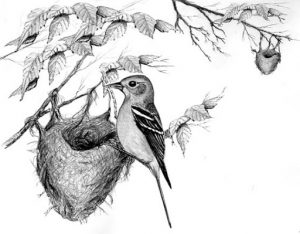 A resident of Setauket, John Turner is conservation chair of the Four Harbors Audubon Society, author of “Exploring the Other Island: A Seasonal Nature Guide to Long Island” and president of Alula Birding & Natural History Tours.
A resident of Setauket, John Turner is conservation chair of the Four Harbors Audubon Society, author of “Exploring the Other Island: A Seasonal Nature Guide to Long Island” and president of Alula Birding & Natural History Tours.

